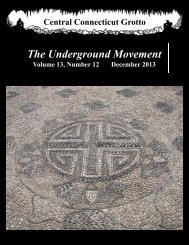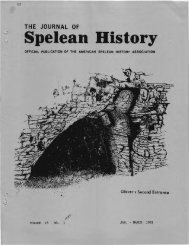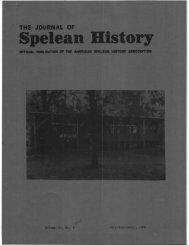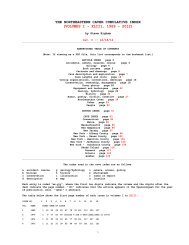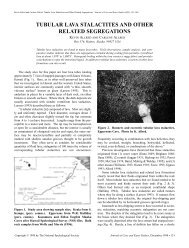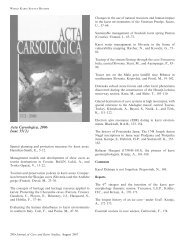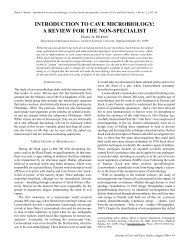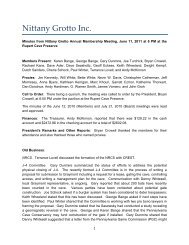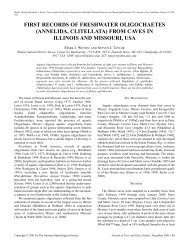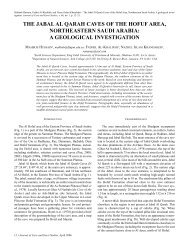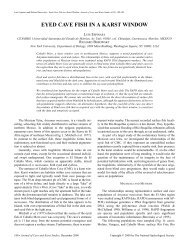2006 Grotto Officers & Staff - National Speleological Society
2006 Grotto Officers & Staff - National Speleological Society
2006 Grotto Officers & Staff - National Speleological Society
Create successful ePaper yourself
Turn your PDF publications into a flip-book with our unique Google optimized e-Paper software.
BIG Newsletter Volume 20#4 March <strong>2006</strong><br />
Page 1<br />
The BIG Newsletter is published on an irregular basis by the Bloomington Indiana <strong>Grotto</strong> of the <strong>National</strong> <strong>Speleological</strong><br />
<strong>Society</strong>. Permission is granted to all internal organizations of the NSS and the Speleo Digest to reprint<br />
material in this newsletter with proper credits to the author and the BIG Newsletter.<br />
© Copyright <strong>2006</strong>: Bloomington Indiana <strong>Grotto</strong>, Inc. PO Box 5283, Bloomington, IN 47407-5283<br />
Editorial correspondence: articles, suggestions, and address changes should be sent to the editor. The editor<br />
reserves the right to choose the publication order of submitted articles.<br />
Exchanges: should be sent to the post office box listed above. Exchange editors may request text and illustrations<br />
in electronic format.<br />
Signed articles do not necessarily express the opinion of the <strong>National</strong> <strong>Speleological</strong> <strong>Society</strong>, the Bloomington<br />
Indiana <strong>Grotto</strong>, or the editor. Unsigned material may be attributed to the editor.<br />
<strong>2006</strong> <strong>Grotto</strong> <strong>Officers</strong> & <strong>Staff</strong><br />
Chairman: Patti Cummings<br />
513 W. Dixie St. Bloomington, IN 47403-4707<br />
Home: 812-339-2130 e-mail: cavelaw2002@yahoo.com<br />
Treasurer: Sam Frushour<br />
513 W. Dixie St. Bloomington, IN 47403-4707<br />
Home: 812-339-2130 e-mail: frushour@indiana.edu<br />
Vice Chairman & Secretary: Dave Everton<br />
7240 Zikes Rd. Bloomington, IN 47401-9261<br />
Home: 812-824-4380 e-mail: deverton@indiana.edu<br />
Newsletter Editor: Dave Everton<br />
On the cover:<br />
Marianne Batchelder at one of the waterfalls in Click Cave, Washington<br />
County, IN. Photo by Dave Everton with assistance from Tymme Laun.<br />
Special thanks goes to all contributors of material<br />
for this newsletter, as well as those persons who<br />
provided editorial assistance and other advising.<br />
Inside this issue:<br />
Announcements & Upcoming Events 2<br />
Belize Cave Rescue Training Trip 2003<br />
by Anmar Mirza<br />
Motorcross Cave<br />
by Landon Parks<br />
Nut Hole Pit<br />
by Dave Everton<br />
Lemon Cave<br />
by Dave Everton<br />
3<br />
5<br />
7<br />
8<br />
A few words from the editor:<br />
Greetings to cavers near and far! This is my second attempt at publishing<br />
a newsletter and I’m still quite honored to have the opportunity.<br />
Over 3 years have passed since the last BIG Newsletter, and various<br />
grotto members are always caving somewhere and doing something! In<br />
an effort to broaden the material published by this group, I encourage all<br />
readers to consider future submission of anything they might consider<br />
worthwhile sharing with other cavers in Indiana and surrounding states as<br />
well as a national audience. Today’s technology makes it easier than<br />
ever to participate. Let’s get those submissions into me for inclusion in<br />
future (and perhaps more frequent; no promises!) newsletters. I’m looking<br />
forward to hearing from you!! Cave safely and softly! Dave<br />
Lemon Pit<br />
by Dave Everton<br />
Snyder Hole<br />
by Dave Everton<br />
Linthicum Spring Cave<br />
by Dave Everton<br />
Sullivaneers 40-year Reunion<br />
by Sam Frushour<br />
Richard Blenz Nature Conservancy<br />
by Dave Everton<br />
9<br />
10<br />
10<br />
12<br />
14
BIG Newsletter Volume 20#4 March <strong>2006</strong><br />
Announcements & Upcoming Events<br />
Page 2<br />
posted on the BIG website at http://www.caves.org/grotto/big/<strong>2006</strong>events.htm<br />
• May 5-7, <strong>2006</strong>: 19 th Annual HogFest sponsored by the Harrison-Crawford <strong>Grotto</strong> at Richard<br />
Newton’s farm north of Marengo. On-site camping, bonfires, food, and of course, lots of caves!<br />
For more information visit http://www.caves.org/grotto/hcg/ or call David Black at 812-738-<br />
9822, or e-mail him at dblack@venus.net<br />
• May 20-21, <strong>2006</strong>: Buckner Cave Graffiti Removal Project, Buckner Cave on the Richard Blenz<br />
Nature Conservancy property. This will be the first real ‘work weekend’ using special sandblasting<br />
equipment designed for the purpose, owned by the Peppersauce Cave Conservation Project.<br />
For more information, visit the RBNC Web site at<br />
http://www.caves.org/grotto/big/rbnc/Graffiti%20Removal.htm<br />
or contact Dave Everton (info on inside cover of newsletter)<br />
• May 26-28, <strong>2006</strong>: 35th annual Kentucky Speleofest. at the Hart County Fairgrounds, Munfordville,<br />
Kentucky. For more information contact Shelly Wolf (chairman) at cavewolf@hotmail.com<br />
or visit the Web site at http://www.caves.org/grotto/louisvillegrotto/Speleofest<strong>2006</strong>.htm<br />
• June 1-4, <strong>2006</strong>: SERA Cave Carnival at Bucks Pocket State Park, Alabama. Preregistration<br />
forms at http://www.caves.org/grotto/cag/SERA.htm or call Michael Gilbert at 256-223-2228.<br />
• June 3, <strong>2006</strong>: Tour of Lost River Karst System led by Robert Armstrong, Chairman of the Lost<br />
River Conservation Association. Meet at 7:40 A.M. on the southeast corner of the town square<br />
in Orleans, Indiana. (Contact Dee Slater at 317-253-6951)<br />
• June 23-25, <strong>2006</strong>: Cave Capers, Camp Rivervale, south of Bedford, Indiana. For more information,<br />
visit http://www.cavecapers.com<br />
• July 14-16, <strong>2006</strong>: Karst-O-Rama, Great Saltpetre Preserve near Mount Vernon, Kentucky. Contact<br />
Dennis Wortman 513-851-2493 or denny1@prodigy.net for details.<br />
• August 7-11, <strong>2006</strong>: NSS <strong>National</strong> Convention, Bellingham, Washington. Visit the official Web<br />
site at http://www.nss<strong>2006</strong>.com<br />
• September 23, <strong>2006</strong>: Tour of Lost River Karst System led by Robert Armstrong, Chairman of<br />
the Lost River Conservation Association. Meet at 7:40 A.M. on the southeast corner of the town<br />
square in Orleans, Indiana. (Contact Dee Slater at 317-253-6951)<br />
• July 23-27, 2007 NSS <strong>National</strong> Convention, Marengo, Indiana. Visit the temporary (unofficial)<br />
Web site at http://www.con7.org
BIG Newsletter Volume 20#4 March <strong>2006</strong><br />
Belize Cave Rescue Training Trip 2003 article & photos by Anmar Mirza<br />
Page 3<br />
Monday March 17: Jim, Laura, and I meet at Don's<br />
to go over last minute seminar and travel planning.<br />
We're going to leave from Don's since he lives closest<br />
to the airport.<br />
Tuesday March 18: We head to the airport. They<br />
won't let Don take his guitar on the plane so he<br />
fumes every time he sees someone else with one.<br />
No major incidents getting to Belize City, Belize.<br />
Small Airport, 4 terminals. We get there in the afternoon<br />
and are met by Cameron and Dave. Dave is<br />
with the DOA. On the way to Cahal Pech in Cayo district<br />
we go over the packet and Cameron drops it off<br />
to be copied on the way. We get to Cahal Pech Village<br />
and are checked into nice little cabana, one for<br />
Don and I, Lamanai, and Pilar for Jim and Laura.<br />
Dinner is at 7. We talk with Cameron extensively<br />
about the seminar. We meet Richard who is a local<br />
guide who hangs out at the hotel. Nice guy. Says<br />
he'll take us to come cliffs we can use in the morning.<br />
Wednesday March 19: In the morning we eat breakfast<br />
at 7, Belize Breakfast. Eggs, sausage, refried<br />
beans, fried jacks (deep fried flour tortillas). I'm<br />
drinking coffee because there is a real lack of Diet<br />
Mt. Dew in this country. Meet a US couple, expatriots.<br />
The wife makes some offhand comment about<br />
wishing she could participate in the rescue seminar.<br />
I think we scared her with our response (we're looking<br />
for a patient...) Meet Richard to go see the cliffs.<br />
They'll work, but nothing really good. Close proximity<br />
at least. Get back to the hotel and meet Cameron to<br />
go to Actun Tunichal Maknal, the cave we're going<br />
to use for the mock. Half hour hike from the parking<br />
area. Cave entrance is AWESOME! Picturesque as<br />
all hell. There are tours in the cave as we go in so<br />
we go upstream past them. What great caving.<br />
70+F, water was almost warm. On the way out Cameron<br />
gave us a private tour of the artifacts and<br />
sites. Lots of pots, shards, skeletal remains, etc.<br />
Nothing really tight in the cave for the patient but a<br />
good search problem. We get back and after dinner<br />
pile five of us into a tiny cab to go down to San Ignacio<br />
to a hotel bar Cameron goes to. Laura tells me<br />
about the great Pina Coladas they have in Belize so<br />
I ordered one. Since I don't drink I have little experience<br />
with such things, but it was indeed good. War<br />
breaks out all over.<br />
Thursday, March 20: Still war when we get up. Don<br />
is a news junkie so I am forced to endure the mindless<br />
tedium of television. No big deal. After breakfast<br />
Cameron takes us to Caracol, one of the major<br />
Mayan sites in Belize. Handy having an archeaologist<br />
as a tour guide. The site is pretty impressive.<br />
Temple pyramid ruins indicating a sizable city. Don<br />
and I raced to the top of the tallest one and it's<br />
pretty high up, we were well above the tree tops.<br />
This evening is our first meeting with the students.<br />
Intros and class format stuff. Our students are a diversity<br />
of people. Some from the DOA, some from<br />
the Ministry of Tourism, a couple of US grad student<br />
archaeologists, Belize Defense Force, Police, and a<br />
lot of tour guides.The class packet looks really good.<br />
36 students in all.<br />
Friday March 21: Vertical day. We break the class<br />
up into two groups. A basic and an advanced group.<br />
Don, Jim, and Laura take the basic group for his lecture:<br />
"Sex, gravity, and nylon fiber." an intro into basic<br />
vertical caving technique. I have the remaining<br />
four people for haul/lowering system theory, anchor<br />
systems, and counterbalances. Then in the afternoon<br />
we rejoin Don's group at the river cliff site. We<br />
find that the site we wanted to use over the water<br />
was probably not good due to the fact that Don's<br />
group spotted an 8' crocodile there when they got<br />
there... We get the whole class together to have the<br />
advanced group rig haul and lower systems and<br />
haul and lower some of the basic class. Everyone<br />
seemed to have fun. I demonstrated a pick-off, how<br />
to rescue someone on rope and we'd had to backtie<br />
the hell out of the spindly little sticks they were using<br />
for vertical practice so it would hold Jim and I.<br />
That evening the four of us went to town for another<br />
round of drinking (a lively group, none of the four of<br />
us are regular drinkers...). This time I was disillu
BIG Newsletter Volume 20#4 March <strong>2006</strong><br />
Page 4<br />
sioned to find they made the Pina Coladas out of<br />
the same mix they use at home. On the walk back<br />
to the hotel we stopped at the Princess Casino so<br />
Don could teach us BlackJack (he'd just built his<br />
own table we were admiring before we left his<br />
place). They confiscated my leatherman at the<br />
door... I lost four bucks on the slots while waiting<br />
for the table to open. Then, with $15 in hand we<br />
played blackjack for an hour or so, having a lot of<br />
fun and we all walked out having made a little<br />
money except Laura, who lost a buck in the slots.<br />
That brings my total gambling winnings up to about<br />
$8. Time to quit while ahead…<br />
Saturday, March 22: Class bright and early. This is<br />
routine for us, just have to change the lectures a<br />
little bit to fit local conditions. Lectures go mostly<br />
ok. Litter handling in the afternoon, same site as<br />
yesterday. First time I've ever had barefoot litter<br />
handlers. Never would have this in the US. One of<br />
the police was wearing his sidearm. Never had that<br />
either :) Different cultures and all. After the evening<br />
enrichment session one of the students took us<br />
down to a local bar, Coconuts. I swear I've spent<br />
more time in bars on this trip than I ever do. It was<br />
fun. I finally found someone I could pump for local<br />
history, vital statistics for Belize, etc.<br />
Sunday, March 23: Mock Rescue day. I get out with<br />
the first group and meet Dave and Eleanor L., our<br />
patients. I take them in and place them, flagging<br />
off the archeaologically sensitive sites on the way.<br />
Eleanor will be our walk out patient and Dave is the<br />
carry out. Dave is placed in a little side passage off<br />
the main stream. I'm to be his guardian angel. It<br />
wasn't ten minutes after I got him placed that we<br />
heard the students in the main passage. They<br />
quickly found him with a bit of yelling. The two<br />
barechested men who found him (another thing we<br />
wouldn't have in the US with our much colder<br />
caves and liability-scared society) quickly got word<br />
back out of the cave. The next two in had a little bit<br />
of first aid training and securely duct taped Dave's<br />
arm and leg. Duct tape and SAM splints, gotta love<br />
it, can't remember how many patients I've taken<br />
out of a cave so trussed.The medic arrived and<br />
soon had Dave in the litter. Then started a marathon<br />
evac. Normally the guardian angel stays within a<br />
short distance of the patient but I could not, the litter<br />
team was moving too fast. I almost got trampled a<br />
couple of times until I backed off a hundred feet<br />
ahead. I had images of bootprints on my back. Funniest<br />
event in the whole evac was one student diving<br />
under the litter to be a turtle in a deep spot. He didn't<br />
quite make it to the surface and all we heard was<br />
somewhat urgent spluttering from under the litter.<br />
They made it out a few minutes earlier than our time<br />
estimate of 3pm, so did a great job. On the way<br />
home Don and I spotted the home of the running W.<br />
Inside joke.<br />
Monday, March 24: Our big day off. We're so tired<br />
and it's gloomy and rainy outside so snorkeling and<br />
tubing don't sound as appealing as they did when we<br />
were hot. We decide to walk around town, our first<br />
real chance. While downtown we started to get hustled<br />
while waiting for Jim and Laura to pick out some<br />
stuff in a store, so once they came out we got away<br />
fast. Back at Cahal Pech village we went to the Cahal<br />
Pech Mayan site. We split up there and Don and I<br />
hung around the site exploring while Jim and Laura<br />
went into town for lunch. Later that afteroon I embarked<br />
on my quest to find a working internet site<br />
and managed to find one whose connection was<br />
working sporadically. After dinner we packed<br />
our stuff for the trip home.<br />
Don Paquette in the entrance to Actun Tunachil Maknal<br />
photo by Anmar Mirza
BIG Newsletter Volume 20#4 March <strong>2006</strong><br />
Page 5<br />
Tuesday, March 25: Dave (the driver, not the patient)<br />
picked us up in the DOA van and took us to<br />
the airport in Belize city. I almost lost my leatherman<br />
forgetting to put it on my check through baggage<br />
but they took pity on me and let me back in<br />
the back to stuff it in. The flight out was uneventful<br />
until we got to Houston. We had 50 minutes to<br />
get off our aircraft, go through immigration, pick<br />
up our bags, go to customs, check our bags back<br />
in, go through security, and board the same damn<br />
aircraft. Naturally we were in the back of the<br />
plane. Naturally we were at the end of every long<br />
line. I discovered that if you take a picture of<br />
friends while in line at immigration it causes a lot<br />
of excitement. Wish they'd posted signs like they<br />
did down in customs. Fortunately since I was using<br />
digital they let me erase the picture instead of<br />
taking the camera. We barely made the aircraft. I<br />
was running barefoot since I took my boots off to<br />
avoid being hassled at the stupidly hyperparanoid<br />
security. Jim and Laura made it into the aircraft at<br />
the last possible instant. We got back to Indy on<br />
time and made it back to Don's ok. I made it home<br />
around 2am.<br />
1200 year-old skull in Actun Tunachil Maknal<br />
photo by Anmar Mirza<br />
Mock Resucue in Actun Tunachil Maknal<br />
photo by Anmar Mirza<br />
Motorcross Cave by Landon Parks<br />
The cave is located approximately halfway between<br />
Bedford and Mitchell, Indiana. Although it<br />
is not a real long cave, I find it interesting nonetheless.<br />
I first heard about it from my Mom. She<br />
had grown up nearby and had always heard a lot<br />
about it. She has told me of some pretty wild<br />
tales about it. One was that a panther escaped<br />
from a circus and was found dead inside the<br />
cave. I really do not hold too much trust in that<br />
story, but find it interesting anyway. Another story<br />
I heard from a friend was that a few years back<br />
(1940s?), a man connected it to the Spring Mill<br />
area. I highly doubt this, although I am not ruling<br />
anything out at this time.<br />
So, I decided to tell a friend of mine, Dave Everton,<br />
about the cave. He offered to go down there<br />
and check it out. A few weeks later, Dave, Sam<br />
Frushour, his wife Patti Cummings, and I headed<br />
down to the cave. Upon arriving, we talked to my<br />
uncle a little, and then got our caving gear and<br />
headed to the entrance, which is not very far from<br />
the road; I would say about 1000 feet or so. Getting<br />
to it is no problem, although there is a large<br />
amount of trash in the sinkhole containing the<br />
cave, and inside the cave is a fair share of trash as<br />
well. I would say a good cleanup is due!<br />
After we checked out the area around the cave, I<br />
headed inside, followed by Sam and Dave. (Patti<br />
stayed outside to read.) After about seven feet in,<br />
you come to a place were you're required to<br />
squeeze through a one-foot high section for a very<br />
short distance. After the small crawl, you come to
BIG Newsletter Volume 20#4 March <strong>2006</strong><br />
a passage that goes both left and right. The passage<br />
to the right contains most of the cave. Upon turning<br />
right, you will notice this passage is also taller than<br />
the left hand passage.<br />
The right-hand passage is about three to four feet<br />
high and has a large amount of trash, including a<br />
few old tires. The passage soon ends, as it becomes<br />
too tight to continue. The passage to the left of the<br />
entrance crawl is about 20 feet long and is very tight<br />
in places. The ceiling is also very loose, and care<br />
should be taken. The average height is around one<br />
foot, but gets as tight as seven inches in one spot.<br />
There may be an opportunity for a dig in this section,<br />
where some breakdown shows that there might be a<br />
Page 6<br />
passage under it. I hope to dig in the future.<br />
There are a lot of other sinkholes in the area,<br />
and I intend on checking some out. Hopefully, I<br />
can find more than one entrance to the cave<br />
(in case the owner fills in the current entrance).<br />
The reason I worry about the owner doing this<br />
is that a few years back, my Mom and I walked<br />
back there to find it had been completely covered<br />
up. At the time I had thought, “Well that's<br />
a cave I will never know about." However, a<br />
few months ago, I walked back there while visiting<br />
my aunt to find it was open with an entrance<br />
height of about 3 feet and the width at<br />
the drip line being 16 feet.
Nu t Hole Pi t by<br />
BIG Newsletter Volume 20#4 March <strong>2006</strong><br />
Nut Dave Hole Everton Pit by Dave Everton<br />
Nut Hole Pit is located on the Scales farm west<br />
and slightly south of Ellettsville. The first known<br />
caver visitation and documentation was by Randy<br />
Jackson and Anmar Mirza in June of 1985, at<br />
which time Randy drafted a map of the small cave<br />
but didn’t publish it. Early in 2002, Dave Everton’s<br />
barber Kenny Scales (the Stylemaster of Ellettsville)<br />
mentioned the existence of a small cave with<br />
a vertical entrance on his property near Mallory<br />
Road. From the initial discussion, Dave believed it<br />
might not have been previously recorded by<br />
cavers, but after a visit on July 12, 2003 and another<br />
look at the Nut Hole map Randy had shared<br />
with him the previous year, as well as Randy’s reported<br />
location, it was easy to determine it was<br />
the same cave.<br />
Kenny had always been curious about his cave,<br />
and graciously took Dave & Rob Serbent there in<br />
his truck on a path his visiting brother John from<br />
Florida made easier by bushhogging. John also<br />
visited the cave that day, as well as their nephew<br />
Bob, who is into rock climbing.<br />
Page 7<br />
The cave may be free-climbed, but vertical gear is<br />
suggested. The 3-foot by 4-foot entrance opening<br />
is a slot dropping 22 feet to a pile of logs and<br />
mud, most likely on top of rock. A second, slightly<br />
offset drop of 12 feet leads into a single dome<br />
room containing a small amount of flowstone.<br />
There is a crevice in the floor and along the west<br />
wall heading in what appears to be an upstream<br />
direction from the drain, and at one point widens<br />
out underneath, but would require physically moving<br />
solid rock to access. No significant airflow was<br />
noted, however. The limestone is sculpted and<br />
clean, and the cave contained some small bones.<br />
Life noted on the 1985 visit included salamanders,<br />
crayfish, a fly, and a worm. Only salamanders<br />
were seen on the recent visit. The cave is in<br />
line with three other sinkholes, none of which contain<br />
any accessible passage or noticeable airflow.<br />
Dave and Rob surveyed the cave on their visit, and<br />
Randy agreed to combine their efforts with his<br />
1985 plan view to produce a map including a profile<br />
view and publish it with landowner approval.
BIG Newsletter Volume 20#4 March <strong>2006</strong><br />
Page 8<br />
Lemon Cave by Dave Everton<br />
Lemon Cave was visited and documented by<br />
George Murphy of the Southern Indiana Speleo<br />
Group (SISG) in 1972. The state files indicated<br />
that he, Art Gahimer, and George Murphy Sr. had<br />
mapped 243 feet. Personal communication with<br />
George Jr, Art, and Buddy Rogers did not come<br />
up with a map, and I couldn’t come up with any<br />
evidence that it had been published (although a<br />
map was later found by Keith Dunlap). At the<br />
time, this warranted a resurvey to take place,<br />
and provided a nice short trip for Steve Clark and<br />
me.<br />
The cave is developed in the Beech Creek limestone<br />
and is located on a hillside about a mile<br />
northeast of Sharkey Church, which is west of<br />
Ridgeport along IN54 in Greene County. The entrance<br />
is located in a shallow sinkhole measuring<br />
eight feet in diameter and two feet deep at<br />
most. At an elevation of 635’, the opening is an<br />
18” diameter hole in sandstone requiring one to<br />
climb down six feet into a room that slopes downward,<br />
contains some breakdown, and has a ceiling<br />
height of about 20 feet. The passage leading on<br />
contains some breakdown and requires climbing<br />
up and down to negotiate. A small dome is soon<br />
encountered, and after a junction is reached with<br />
passages too small for humans, the passage continues<br />
narrow, low, and tight. Steve Clark crawled<br />
in part way and we then terminated the survey. A<br />
smaller person could likely continue, and perhaps<br />
accounts for the difference in horizontal cave<br />
length between the 142 feet we surveyed and the<br />
243 feet reported to the files. We didn’t notice<br />
any other negotiable passages in the cave on our<br />
visit of January 3, 2003. The only cave life noted<br />
was some spiders in the entrance room.
BIG Newsletter Volume 20#4 March <strong>2006</strong><br />
Lemon Pit Cave by Dave Everton<br />
Lemon Pit Cave was visited and documented by<br />
George Murphy of the Southern Indiana Speleo<br />
Group (SISG) in December 1970. He reported it to<br />
be in a large sink opening and contain two pits<br />
measuring 8 and 30 feet deep. I’d located it in the<br />
fall of 2002 and returned to survey it with Steve<br />
Clark on a cold day with snow on the ground in<br />
January 2003.<br />
The small cave is located about ¼ mile southeast<br />
of Lemon Cave and slightly higher, at an elevation<br />
of 660’. The oblong sinkhole is indeed large for<br />
that part of Greene County, measuring 12 feet<br />
wide by 24 feet long by 15 feet deep, with the<br />
walk-in 10-foot high and 4-foot wide entrance located<br />
in the east side of it. The floor is comprised<br />
of very loose, shattered rock and the walls are<br />
about the same. Steve identified it as classic<br />
Beech Creek limestone. A short distance inside on<br />
the right, an offset joint contains a small dome of<br />
Page 9<br />
sorts. Continuing down the sloping floor in the<br />
main passage, one reaches a small hole through<br />
which cave passage can be seen. It appears to<br />
be approximately 4 feet in diameter and Steve<br />
taped it at eight feet deep to a mud floor. Unlike<br />
the rest of the cave, the walls and floor appear<br />
to be very solid in the area of the constriction.<br />
However, we did not attempt to go through it.<br />
The way I understood it from talking with George<br />
Murphy prior to our visit, he believes this area<br />
holds some promise, although it didn’t seem<br />
very appealing to me, nor did airflow seem notable<br />
at the time. Perhaps the 30-foot pit is beyond<br />
here unless it has been covered. I was certainly<br />
tentative while traversing the passage due<br />
to the combination of not knowing where the pit<br />
might be and the very loose rock making up the<br />
floor that shifts greatly with every movement. No<br />
cave life was seen, although an empty bird nest<br />
was seen on a ledge near the entrance.
BIG Newsletter Volume 20#4 March <strong>2006</strong><br />
Page 10<br />
Snyder Hole by Dave Everton<br />
This one-room cave was found by local cavers<br />
Randy and Berniece Snyder close to their property<br />
near Kirksville. The entrance is in a sinkhole<br />
and requires climbing down five feet to the top of<br />
a mud slope that continues down into the cave<br />
at a 45 degree angle. The cave consists of a<br />
small room measuring approximately eight to ten<br />
feet in diameter and eight feet high at most.<br />
There are a couple of small passages that appear<br />
to leave the room but both appear to end<br />
quickly in clay fill. A small drain is present as<br />
well, but is clogged with rock. It doesn’t appear<br />
promising, either. There wasn’t any noticeable<br />
air flow on the day of the survey in January. The<br />
only cave life noted was a couple of crickets.<br />
Nothing else of interest was noted in the cave,<br />
although Randy found some deer bones on the<br />
discovery trip.<br />
Linthicum Spring Cave by Dave Everton<br />
This cave was reported and documented in 1970<br />
by the now long-defunct Mid Illinois <strong>Grotto</strong> (based<br />
out of Champaign-Urbana). They were very active<br />
in cave exploration and surveying in various parts<br />
of Indiana and Kentucky. Although the cave files<br />
reported there to be 30 feet mapped, scouring of<br />
their old newsletters in the BIG library failed to<br />
come up with a map or even a mention of it in a<br />
trip report, although they had also surveyed and<br />
published nearby Linthicum Pit. Somehow (as has<br />
happened with various cave names), the spelling<br />
had been improperly recorded as Lithicum, but<br />
has since been corrected, since Linthicum was a<br />
family name.<br />
During the process of doing some entrance verification<br />
work for the Indiana Cave Survey in early<br />
2003, I left a note at the home of Brad Swain after<br />
a neighbor told me he owned the land I believed<br />
the cave to be on. Brad promptly phoned<br />
me and agreed to allow me to come out and take<br />
a look at the cave. He also mentioned meeting<br />
Jim Johnson one time while taking some extended<br />
learning courses at Indiana University and had told<br />
him of the cave. I later phoned Jim to ask if he’d<br />
be interested in going to look at the cave together,<br />
and we agreed to check it out in warmer weather.<br />
On May 13, 2003, Jim and I were cordially led<br />
down to the entrance in his 4WD truck by Brad in<br />
his Jeep. The water issued out from under a<br />
ledge. Jim plunged in and checked it out, reporting<br />
very low airspace and a possible squeeze of<br />
sorts. There was also an overflow tube, and after<br />
crawling a few feet into it and squeezing through a<br />
short low spot, he reported it to open up. I eagerly<br />
followed, and we subsequently checked out what I<br />
estimated to be between 150-200 feet of cave<br />
with an upper level lead. We departed unsure if<br />
the upstream end continued or not since we weren’t<br />
fully prepared for caving. What we did see<br />
turned out to be a pleasant surprise, and for little<br />
to no effort, at that. It had paid off to look at it,<br />
and although it certainly can’t be considered<br />
among Indiana’s finest, it wasn’t a slop hole.
BIG Newsletter Volume 20#4 March <strong>2006</strong><br />
Page 11<br />
Saturday, June 7, 2003 found Sam Frushour,<br />
Rob Serbent, Jim Johnson, and me at the cave<br />
with the intention of surveying and exploring further<br />
as needed. We spent about two and a half<br />
hours inside, tallying a little over 300 feet of survey<br />
and taking a few photos (none of which<br />
turned out due to my camera messing up). Rob<br />
pushed the upstream area by holding his breath<br />
through a short 3-inch airspace spot, and<br />
popped into another airspace area with an 8-foot<br />
ceiling height. However, the cave sumped for<br />
sure in that room, and may be the future site of<br />
a cave dive by Sam. While exiting the cave, instead<br />
of taking the tube entrance crawl, Jim<br />
stayed in the stream and found it comfortable<br />
and easy in his wetsuit through the low area.<br />
The entrance to the cave is 6 feet high by 10<br />
feet wide, with a stream issuing from the right<br />
side. 25 feet left of the entrance is an 8-foot<br />
wide annex-type entrance that pinches out almost<br />
immediately after entering. The cave is entered<br />
using the arch-shaped 3-foot high overflow<br />
tube. After a short section of hands & knees crawl<br />
and then a very short squeeze, the passage opens<br />
up and is easy to traverse, averaging 5 feet high<br />
with a foot or more of water. Soon, a dome is<br />
reached, where a dry, narrow canyon passage<br />
eventually heads back toward the entrance. Further<br />
upstream, another parallel passage may be<br />
entered, but both ends are clay-filled. A little further<br />
in the main passage, the near-sump and<br />
sump are reached. Spiders and salamanders<br />
were noted in the dome junction room. The cave<br />
contained a few small speleothems here and<br />
there, but nothing special.<br />
<strong>2006</strong> Update: Sam and Chris Parks returned and<br />
dove the siphon at the upstream end of the cave,<br />
and the passage continues. They hope to return<br />
for further exploration.
BIG Newsletter Volume 20#4 March <strong>2006</strong><br />
Page 12<br />
Sullivaneers Reunion by Sam Frushour<br />
You know you have been going around the block<br />
a while when the people you caved hard with for<br />
years are no longer caving. That was the feeling I<br />
had, when on the 40th anniversary of the second<br />
Sullivan Cave Expedition, people showed up to<br />
celebrate who were a part of the endeavor to<br />
complete the mapping and further psychological<br />
testing of isolated groups in a cave. Three people<br />
were contacted who wished to participate, but<br />
could not do so. So there we were on August 16,<br />
2003 gathered near the Sullivan Cave entrance<br />
with a picnic setup and reminiscing about how<br />
things were in 1963. Gathered at the outing were<br />
Fred Steinhoff, Darrell Kirby, Tom Rea, and Sam<br />
Frushour. Unable to attend were Leigh Lawton,<br />
Richard Blenz and Larry Mullins. Other expedition<br />
members not in attendance were Mike Wischmeyer<br />
who is reported by Darrel to be in Texas<br />
and had sold his soul to the Exxon Oil Company<br />
where he is an executive, Richard (Dixie) Dickson’s<br />
whose whereabouts are unknown, Bob Larsen<br />
who was not found as well, Rodney Grant<br />
who is in ill health somewhere in Colorado, and<br />
Mike Mann, who also could not be located.<br />
A brief recap of events leading up to the expedition<br />
is provided here for those who were likely not<br />
even born when the event took place. This was a<br />
time when we really did not know what worked<br />
best for getting a large cave mapped. The mapping<br />
of Sullivan Cave had begun in 1958 under<br />
the direction of Art Davis who (along with John<br />
Danner) discovered the lower level of the cave in<br />
1956. In bits and pieces the cave map grew, but<br />
with several mappers losing interest in the late<br />
1950s, effort lapsed until Art turned the effort<br />
over to Mike Wischmeyer in 1962. Mike organized<br />
six of his cave friends into an effort to map<br />
the cave by staying in it for two weeks in August<br />
of 1962. They had some logistic problems with<br />
supplying the underground camp and running a<br />
phone line for outside communication and up to<br />
the Quarry Room. These things cut into the time<br />
allowed for mapping, as did taking a couple of<br />
psychological tests for Dr. David Torbet of Butler<br />
University. They did map several thousand feet of<br />
passage, but the whereabouts of the main stream<br />
in the north end of the cave eluded them and<br />
posed a haunting dilemma. On September 23,<br />
1962 after the end of the first expedition, Mike<br />
Wischmeyer, Tom Rea, Leigh Lawton and Sam<br />
Frushour were working their way up the Flood<br />
Route of Sullivan River securing the phone line<br />
laid for the expedition. Just before the North Y<br />
they encountered a small canyon on the left that<br />
none of them had previously entered. While Tom<br />
and Leigh continued fastening up the wire, Mike<br />
and Sam squirmed into the canyon on their sides<br />
and after about 40 feet negotiated a tight lefthand<br />
right angle bend that led them into a muddy<br />
room with a canyon leading upward to the north.<br />
This led to the Bat Room and several leads that<br />
did not go, but one to the west was not taken due<br />
to lack of time. A couple of weeks later on October<br />
7, Leigh Lawton, Ron Pflum, and Frushour followed<br />
that western lead through Side Crawl to a<br />
junction where they found themselves in known<br />
passage called Endless Crevice (also Crevice Passage).<br />
Arrows on the wall at this junction indicated<br />
that someone had previously come from<br />
both directions, but did not know what they had<br />
accomplished. Mike Wischmeyer’s group coming<br />
from the entrance area had gone into the Waterfall<br />
Crevice area and the two groups never joined<br />
Members of the Sullivan Cave Expedition at the 40-year Reunion from<br />
left to right: Tom Rea, Sam Frushour, Darrel Kirby, & Fred Steihhoff
BIG Newsletter Volume 20#4 March <strong>2006</strong><br />
Page 13<br />
that day. Mike had with him Richard Dixon, and<br />
Calvert Jarod. A week later, to the day, the connection<br />
of the entrance area and Side Crawl was<br />
made by Pflum, Lawton, and Frushour during<br />
mapping and with Wischmeyer going down Endless<br />
Crevice. As the survey progressed through<br />
Side Crawl to Endless Crevice voices were heard<br />
and the two groups joined whooping it up. The<br />
area from the Flood Route to Connection Y at Endless<br />
Crevice is known as the Crevice Connection<br />
Area.<br />
Finding new passages helped spur renewed interest<br />
in the cave and especially for finding passages<br />
north of the Quarry Room. In 1960 a group of<br />
cavers that included Bob Armstrong and Patricia<br />
Humphrey went through a bathtub and into a<br />
room that required negotiating a bathtub to continue<br />
beyond. They passed a second short bathtub<br />
and found themselves in a small breakdown<br />
room with a side passage and a larger passage<br />
ahead. They continued ahead to a junction and<br />
went left scrambling through breakdown; eventually<br />
finding they had to climb a mud bank and<br />
scramble through more breakdown. They did not<br />
know it at the time, but they bypassed the main<br />
stream passage and a great discovery when they<br />
climbed the mud bank. They turned around in a<br />
breakdown-choked passage and left the cave. On<br />
the first expedition the side passage at the Safety<br />
Room was mapped and the way north not found.<br />
Wischmeyer, Lawton, and Kirby realized this mistake<br />
after the first expedition and wished to go<br />
north to find the way on from the Safety Room.<br />
On December 15 of 1962 Wischmeyer, Lawton,<br />
Pflum and Frushour slogged up to the Quarry<br />
Room and 3000 feet beyond to the First Bathtub.<br />
The water was reasonably low, so going through<br />
the bathtub meant you had to close one eye during<br />
the last ten feet of submersion. After going<br />
through the Bathroom and the Second Bathtub<br />
the breakdown of the Safety Room was climbed.<br />
On the first expedition the Safety Room was given<br />
that name because it was the only high ground<br />
found that did not appear to totally flood. Instead<br />
of going around the side of the rock pile as was<br />
done on the first expedition, when Safety Room<br />
Crawl as found and mapped, the group now went<br />
right over the top of the breakdown and encounwater<br />
going north. This passage brought them out<br />
on a high mud bank T-ing into a larger passage<br />
containing a partially breakdown-choked passage<br />
ahead. To the right a short distance was a breakdown<br />
room, but they were still looking for a major<br />
stream so they retraced and went west. After only<br />
a couple of minutes they climbed a breakdown<br />
slope with a dark void above and found themselves<br />
in what is now named the Coliseum, a huge<br />
room without a mountain in the center. Continuing<br />
on after ooing and aaahing in the room, they<br />
scrambled through more breakdown and found<br />
themselves at the base of a mud bank and after<br />
climbing it, another breakdown room was found.<br />
They noted that the 1960 group must have surely<br />
taken the side passage just beyond the room and<br />
did not take notice of the gaping darkness downhill<br />
to the left that was the main stream passage.<br />
On this discovery date the group walked and<br />
scrambled upstream past several breakdown<br />
rooms and high mud banks until they reached<br />
they reached the base of a gigantic breakdown<br />
slope that trailed off and up into a huge gaping<br />
dark void. They climbed what seem like forever<br />
and found themselves at the top of a great breakdown<br />
mountain approximately 100 feet high with<br />
a flat ceiling 20 feet above. This was the Colossus,<br />
the highest room in the cave. That December<br />
day of great discoveries set the stage for more exploration<br />
and ultimately for the Second Sullivan<br />
Cave Expedition.<br />
Now there was a large stream chugging off to the<br />
north and seemingly no end to the cave. Subsequent<br />
visits found more passage and rooms.<br />
There was Room Five beyond the Colossus, then a<br />
four hundred-foot long near-bathtub, and finally<br />
Room Six located just before a Y junction where<br />
streams came from two directions. To the left was<br />
found a long rectangular room with a semicircular<br />
breakdown (Room Seven) at the north end. The<br />
right hand stream passage went to a room where<br />
the stream disappeared into breakdown at a the<br />
start of the room. Frushour moved some rocks<br />
along the right wall and climbed down to the hidden<br />
stream below.
BIG Newsletter Volume 20#4 March <strong>2006</strong><br />
Page 14<br />
They waded waist-deep through a small forest of<br />
rock pillars, eventually finding a stream crawlway<br />
on the right (Salamander Crawl) and breakdown<br />
on the left. Climbing between stone blocks they<br />
entered another large breakdown room. (Room<br />
Eight). Unknown to the explorers, they were<br />
standing within a few feet of where the main<br />
stream of the cave rises from a flooded passage.<br />
This fact was not found until surveying was going<br />
on only a week into the Second Expedition.<br />
And so there we were on a warm August day, 40<br />
years later, enjoying the company of our friends<br />
and loved ones with caving done and a good<br />
meal. Many of the attendees had gone caving<br />
the previous day or on this day and several<br />
guests did entrance to entrance trips so they got<br />
wet swimming out the Speed Hollow entrance. A<br />
great time was had by all.<br />
The entrance to Buckner Cave on the Richard Blenz Nature<br />
Conservancy Property (photo by Jess Deli)<br />
Richard Blenz Nature Conservancy by Dave Everton<br />
It has long been the intention of property owner<br />
Richard Blenz to bequeath his land and underlying<br />
caves to the <strong>National</strong> <strong>Speleological</strong> <strong>Society</strong> (NSS)<br />
upon his departure. In 2005, a formal organization<br />
was formed and subsequently incorporated,<br />
with goals of establishing a solid management<br />
plan for the property that will enable a smooth<br />
transition in ownership when the property transfer<br />
eventually takes place, as well as for the future. It<br />
is now known as the Richard Blenz Nature Conservancy,<br />
Inc.<br />
Access to the property and Buckner Cave will be<br />
determined in part by a person’s membership<br />
level within the Conservancy. Non-member visitation<br />
is being permitted, although arrangements<br />
must be made a minimum of one week in advance.<br />
To ensure the greatest possibility of being<br />
granted access, it is of vital importance that each<br />
visitor reviews and understands the property rules<br />
and regulations before requesting permission.<br />
Each visitor must also sign a Release and Waiver<br />
of Liability Agreement prior to visiting the property.<br />
The Conservancy Board<br />
President: Anmar Mirza<br />
Vice President: Patti Cummings<br />
Secretary: Dick Blenz<br />
Treasurer: Sam Frushour<br />
Graffiti Removal Project<br />
A project is underway to remove graffiti in Buckner<br />
Cave using some special equipment owned by the<br />
Peppersauce Cave Conservation Project and managed<br />
by Ray Keeler. Cavers and groups from all<br />
over the region are invited to participate in the<br />
massive project. Project workday summaries will<br />
be posted to the website (below).<br />
If you know of any scout troops or other groups<br />
that may be interested in participating, or if you<br />
are interested in participating or supporting the<br />
effort, please contact Dave Everton (info on inside<br />
of front cover).<br />
To visit the Richard Blenz Nature Conservancy<br />
Web site, go to:<br />
http://www.caves.org/grotto/big/rbnc/rbnc.htm




